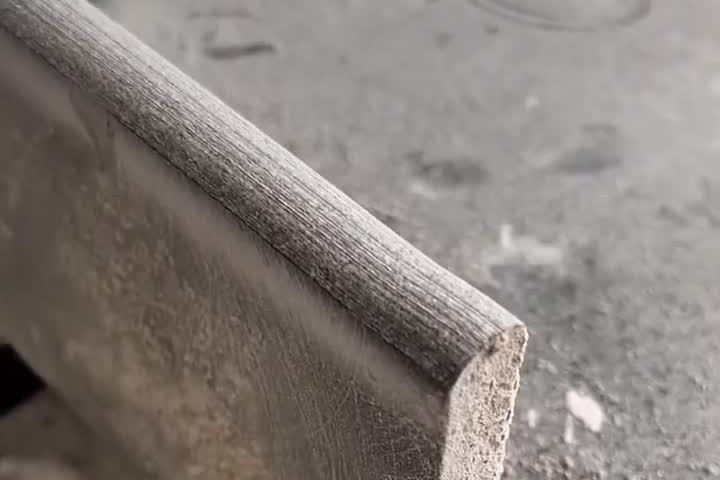Rounding presents a unique challenge when it comes to maintaining the integrity of the sandpaper and achieving a consistent grind. Uneven force and pressure can cause the sandpaper to deform, resulting in poor sanding performance and an inconsistent finish. To avoid this problem and ensure a smooth and efficient grinding process, proper techniques and precautions must be used.
How to Avoid Deformation of Sandpaper
1. Flatten the sandpaper before use
Before using sandpaper, it’s important to place it on a flat surface and flatten it. This simple step can significantly help make the sandpaper flatter and reduce the chance of warping. By ensuring that the sandpaper is flat and free of any irregularities, you minimize the risk of deformation during grinding, resulting in a more consistent and even finish.
2. Use appropriate support and support
Using a backing pad or support during round sanding can help distribute pressure evenly across the sandpaper, reducing the risk of deformation. The backing pad provides stability and support, allowing the sandpaper to maintain its shape and effectiveness throughout the sanding process. This helps prevent localized stress and ensures a consistent and even finish.
3. Choose the right size of sandpaper
Choosing the right size of sandpaper is crucial to preventing deformation during sanding. When sanding circles, sandpaper that is too small will cause deformation, and sandpaper that is too large will cause waste. Therefore, choosing the right size sandpaper to match the dimensions of your workpiece will help avoid deformation and ensure optimal sanding results.
4. Take advantage of support and support
Using a backing pad or support during sanding helps distribute pressure evenly across the sandpaper, reducing the risk of deformation. The backing pad provides stability and support, allowing the sandpaper to maintain its shape and effectiveness throughout the grinding process. This helps prevent localized stress and ensures a consistent and even finish.
5. Regularly monitor and replace worn sandpaper
Monitoring the condition of the sandpaper during the grinding process is critical to ensuring optimal performance. As sandpaper wears away, its ability to maintain its shape and effectiveness diminishes. Worn or deformed sandpaper must be replaced promptly to maintain consistent and high-quality grinding results.
In summary, preventing sandpaper from deforming during sanding requires careful consideration of the flatness of the sandpaper, applying even pressure, selecting the appropriate size, using a backing pad or support, and regularly monitoring and replacing worn sandpaper. By implementing these measures, operators can achieve a more consistent and efficient grinding process, resulting in improved surface finish and overall productivity.
Tips for Effective Sanding of Round Surfaces
Sanding circles present a unique set of challenges, and mastering techniques to avoid sandpaper deformation is critical to achieving the best results. Once you understand the basic principles of preventing sandpaper from warping, there are other tips and techniques that can further enhance the process of sanding round surfaces. Here are some valuable tips for sanding circles effectively:
1. Sand along the circumferential direction
When sanding round surfaces, it is advantageous to sand in the circumferential direction. This technique allows for a smoother, more consistent sanding result because it aligns with the natural curvature of the rounded surface. By following a circular pattern, the sandpaper conforms to the shape of the workpiece, resulting in a more uniform finish.
2. Polish in two directions alternately
For best results when sanding circles, consider alternating the sanding direction between circular and radial modes. By sanding in a circumferential direction for a while and then switching to a radial direction, you can distribute the pressure and wear on the sandpaper more evenly. This method reduces the possibility of the sandpaper deforming, helping to achieve more even and effective sanding results.
3. Feel with your hands whether there is any deformation.
During the sanding process, it is important to feel the sandpaper with your hands for signs of deformation. Tactile evaluation allows you to detect any irregularities or deformations in the sandpaper. If you notice any deformation, it is important to replace the sandpaper immediately to maintain a consistent and high-quality sanding result.
Additional Tips
Grinding Wheel: For larger circles, consider using a grinding wheel on a bench grinder for faster and more efficient material removal.
Sanding Block: A sanding block can provide better control and prevent the sandpaper from bending or tearing.
Pressure Control: Apply consistent, moderate pressure to avoid excessive wear or uneven sanding.
Dust Management: Use a dust collection system or wear a respirator to protect yourself from harmful particles.
Inspection: Regularly inspect the sandpaper for signs of wear or damage.
Common Mistakes to Avoid
Excessive Pressure: Applying too much pressure can cause the sandpaper to deform or burn the workpiece.
Incorrect Sanding Direction: Deviating from the recommended sanding directions can lead to uneven results.
Overheating: Allow the workpiece to cool periodically to prevent burning or warping.
Neglecting Maintenance: Regularly inspect and replace worn sandpaper to maintain optimal performance.
By incorporating these additional tips into the grinding process on round surfaces, operators can further increase the effectiveness and efficiency of their grinding operations. These technologies not only help achieve a smoother, more uniform finish, but they also help extend the life of the sandpaper and ensure consistent performance over a longer period of time.
In summary, mastering techniques to avoid deformation of sandpaper is critical to effectively sanding round surfaces. By following the above tips and incorporating them into the sanding process, operators can achieve superior results, minimize sandpaper deformation, and maintain a high standard of quality in their sanding operations.
Post time: Sep-06-2024

